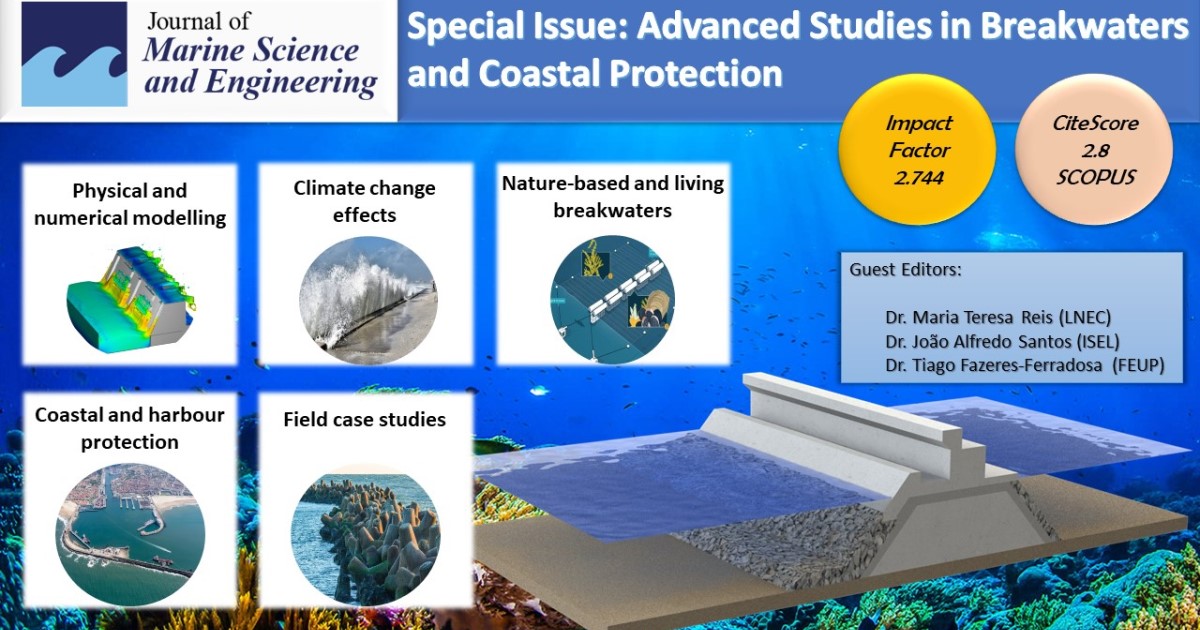Advanced Studies in Breakwaters and Coastal Protection
A special issue of Journal of Marine Science and Engineering (ISSN 2077-1312). This special issue belongs to the section "Coastal Engineering".
Deadline for manuscript submissions: 20 June 2024 | Viewed by 13070

Special Issue Editors
Interests: coastal and maritime engineering; wave overtopping (empirical, physical and numerical models, neural networks); physical modelling of harbor, coastal and underwater structures; monitoring and analysis of the behavior of harbor structures; probabilistic design and assessment of the safety of maritime structures; risk management; coastal flood forecast & warning systems
Interests: ships; numerical modelling; numerical simulation; fluid mechanics; mathematical modelling; naval architecture; shipping; naval hydrodynamics; wave hydrodynamics; hydrodynamic modelling; breakwaters; physical modelling; inspection and diagnosis of breakwaters' status
Interests: offshore foundations; risk and reliability analysis; scour phenomena; sea climate modeling and extreme events theory applied to civil and ocean engineering
Special Issues, Collections and Topics in MDPI journals
Special Issue Information
Dear Colleagues,
Mean sea-level rise is accelerating globally, and the population in coastal zones is gradually growing, including in low-lying coasts. Furthermore, there are mounting demands for deeper harbors to accommodate future deeper-draft vessels that are bought online by shipping companies. Certain areas around the world will also experience more frequent and intense extreme storm events, inevitably leading to increased structural damage, beach/dune erosion, flooding, and saltwater intrusion, amongst other processes. These have anticipated negative impacts on the economy, infrastructure, and human livelihood. Adapted, safe, and sustainable solutions are thus required for the protection of coastal residents, ecosystems, coastal/harbor infrastructure, and the economy.
Breakwaters are commonly utilized to shelter harbor basins and entrances against waves, with different types being used depending on local characteristics (e.g., foundation conditions, water depths, wave climate severity), the size and shape of the area to be protected, availability of large quarry stones, etc. They may be rubble-mound structures armored with rock or concrete armor units, vertical-front structures, or composite structures. Breakwaters have also been integrated in coastal defense schemes with the main objective of preventing shoreline erosion. In this case, detached breakwaters, reef breakwaters, and groins (similar to rubble-mound breakwaters) are more common.
This Special Issue on “Advanced Studies in Breakwaters and Coastal Protection" welcomes original research on innovative methods and technologies for coastal and harbor protection structures, including papers investigating the effects of climate change and the need for sustainable solutions. We also welcome papers focusing on advanced studies (physical and numerical models, field observations, composite modeling, probabilistic approaches) aiming to enhance the reliability of existing structures’ safety and functionality, establish optimal design for new structures, and improve measures to mitigate risks (e.g. warning systems, decision-support tools).
Dr. Maria Teresa Reis
Dr. João Alfredo Santos
Dr. Tiago Fazeres Ferradosa
Guest Editors
Manuscript Submission Information
Manuscripts should be submitted online at www.mdpi.com by registering and logging in to this website. Once you are registered, click here to go to the submission form. Manuscripts can be submitted until the deadline. All submissions that pass pre-check are peer-reviewed. Accepted papers will be published continuously in the journal (as soon as accepted) and will be listed together on the special issue website. Research articles, review articles as well as short communications are invited. For planned papers, a title and short abstract (about 100 words) can be sent to the Editorial Office for announcement on this website.
Submitted manuscripts should not have been published previously, nor be under consideration for publication elsewhere (except conference proceedings papers). All manuscripts are thoroughly refereed through a single-blind peer-review process. A guide for authors and other relevant information for submission of manuscripts is available on the Instructions for Authors page. Journal of Marine Science and Engineering is an international peer-reviewed open access monthly journal published by MDPI.
Please visit the Instructions for Authors page before submitting a manuscript. The Article Processing Charge (APC) for publication in this open access journal is 2600 CHF (Swiss Francs). Submitted papers should be well formatted and use good English. Authors may use MDPI's English editing service prior to publication or during author revisions.
Keywords
- breakwaters
- coastal/harbor protection
- structural damage
- armor-layer damage evolution
- conditioned level III simulation
- wave overtopping
- physical and/or numerical modeling
- field observations
- climate change
- green/gray solutions







